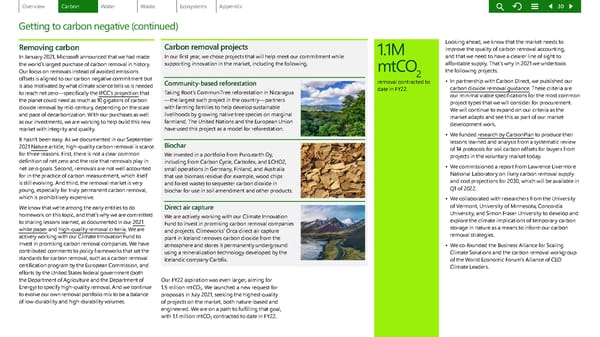Removing carbon In January 2021, Microsoft announced that we had made the world’s largest purchase of carbon removal in history. Our focus on removals instead of avoided emissions offsets is aligned to our carbon negative commitment but is also motivated by what climate science tells us is needed to reach net zero—specifically the IPCC’s projection that the planet could need as much as 10 gigatons of carbon dioxide removal by mid-century, depending on the scale and pace of decarbonization. With our purchases as well as our investments, we are working to help build this new market with integrity and quality. It hasn’t been easy. As we documented in our September 2021 Nature article, high-quality carbon removal is scarce for three reasons. First, there is not a clear common definition of net zero and the role that removals play in net zero goals. Second, removals are not well accounted for in the practice of carbon measurement, which itself is still evolving. And third, the removal market is very young, especially for truly permanent carbon removal, which is prohibitively expensive. We know that we’re among the early entities to do homework on this topic, and that’s why we are committed to sharing lessons learned, as documented in our 2021 white paper and high-quality removal criteria . We are actively working with our Climate Innovation Fund to invest in promising carbon removal companies. We have contributed comments to policy frameworks that set the standards for carbon removal, such as a carbon removal certification program by the European Commission, and efforts by the United States federal government (both the Department of Agriculture and the Department of Energy) to specify high-quality removal. And we continue to evolve our own removal portfolio mix to be a balance of low-durability and high-durability volumes. Carbon removal projects In our first year, we chose projects that will help meet our commitment while supporting innovation in the market, including the following. Community-based reforestation Taking Root’s CommuniTree reforestation in Nicaragua —the largest such project in the country—partners with farming families to help develop sustainable livelihoods by growing native tree species on marginal farmland. The United Nations and the European Union have used this project as a model for reforestation. Biochar We invested in a portfolio from Puro.earth Oy, including from Carbon Cycle, Carbofex, and ECHO2, small operations in Germany, Finland, and Australia that use biomass residue (for example, wood chips and forest waste) to sequester carbon dioxide in biochar for use in soil amendment and other products. Direct air capture We are actively working with our Climate Innovation Fund to invest in promising carbon removal companies and projects. Climeworks’ Orca direct air capture plant in Iceland removes carbon dioxide from the atmosphere and stores it permanently underground using a mineralization technology developed by the Icelandic company Carbfix. Our FY22 aspir ation was even larger, aiming for 1.5 million mtCO 2 . We launched a new request for proposals in July 2021, seeking the highest quality of projects on the market, both nature-based and engineered. We are on a path to fulfilling that goal, with 1.1 million mtCO 2 contracted to date in FY22. Getting to carbon negative (continued) 1.1M mtCO 2 removal contracted to date in FY22. Looking ahead, we know that the market needs to improve the quality of carbon removal accounting, and that we need to have a clearer line of sight to affordable supply. That’s why in 2021 we undertook the following projects. • In partnership with Carbon Direct, we published our carbon dioxide removal guidance . These criteria are our minimal viable specifications for the most common project types that we will consider for procurement. We will continue to expand on our criteria as the market adapts and see this as part of our market development work. • We funded research by Carbon Plan to produce their lessons learned and analysis from a systematic review of 14 protocols for soil carbon offsets for buyers from projects in the voluntary market today. • We commissioned a re port from Lawrence Livermore National Laboratory on likely carbon removal supply and cost projections for 2030, which will be available in Q1 of 2022. • We collaborated with researchers from the University of Vermont, University of Minnesota, Concordia University, and Simon Fraser University to develop and explore the climate implications of temporary carbon storage in nature as a means to inform our carbon removal strategies. • We co-founded the Business Alliance for Scaling Climate Solutions and the carbon removal workgroup of the World Economic Forum’s Alliance of CEO Climate Leaders. 30
 Environmental Sustainability Report | Microsoft Page 29 Page 31
Environmental Sustainability Report | Microsoft Page 29 Page 31